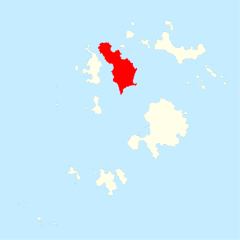Tresco: Difference between revisions
Created page with '{{Infobox island |name=Tresco |cornish=Enys Skaw |group=Isles of Scilly |county=Cornwall |picture=Abbey Gardens, Tresco, Scilly - geograph.org.uk - 1606637.jpg |picture caption=A…' |
mNo edit summary |
||
| Line 6: | Line 6: | ||
|picture=Abbey Gardens, Tresco, Scilly - geograph.org.uk - 1606637.jpg | |picture=Abbey Gardens, Tresco, Scilly - geograph.org.uk - 1606637.jpg | ||
|picture caption=Abbey Gardens, Tresco | |picture caption=Abbey Gardens, Tresco | ||
|map=Tresco | |map=Tresco island Scilly.svg | ||
|map caption=Tresco | |map caption=Tresco | ||
|population=180 | |population=180 | ||
|census year=2001 | |census year=2001 | ||
Latest revision as of 15:52, 29 February 2012
| Tresco Cornish: Enys Skaw | |
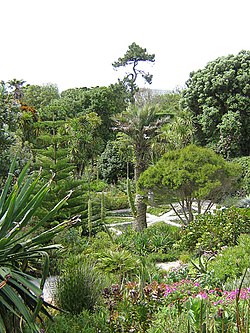 Abbey Gardens, Tresco | |
|---|---|
| Location | |
| Grid reference: | SV893421 |
| Data | |
| Population: | 180 (2001) |
Tresco is the second-largest island of the Isles of Scilly, Cornwall. It is 734 acres in size, measuring about 2 miles long by a mile broad.
The character of Tresco varies from that of the other islands in the Scilly archipelago as it is primarily run as a holiday resort,[1] and virtually all economic activity and employment is tourist-related. On the other inhabited islands tourism is important, but it does not dominate to such an extent. Tresco is owned freehold by the Duchy of Cornwall but leased to the Tresco Estate.
There is one church: St Nicholas (Church of England).
Geography

The isle is rugged, the coast rocky and fierce and inland a variety in such a small space between the bleak and the beautiful.
A variety of scenery is found on the island, including rugged granite outcrops, heathland of the exposed north coast and mainly shell beaches in the east and south.
The island has two villages, New Grimsby and Old Grimsby in central part of the island, where there are a shop and post office, an art gallery, a pub, and a hotel, all of which are owned and run by the Tresco Estate.
At the south of the island can be found the sub-tropical Tresco Abbey Gardens, including the Valhalla Figurehead Collection, and Tresco Heliport. There are bathing beaches at Pentle Bay, Appletree Bay, Gimble Porth, Hotel Beach, Green Porth, Gimble Porth, Rushy Porth. Further north are King Charles's Castle and Cromwell's Castle.
The variety of its scenery and geomorphology is partly a result of the last ice age, where the Devensian ice sheet clipped the north side of the island leaving deformation till deposits.[2][3]
History
In early times one group of islands was in the possession of a confederacy of hermits. King Henry I gave it to Tavistock Abbey which established a priory on Tresco that lasted until the Reformation. The priory was given the care of souls in the secular islands by the lord of the fief.[4] In 1233, a prior here, known as Alan of Cornwall, was made abbot of Tavistock.[5]
The island is named as Trescaw in an 1814 publication,[6] and was described as 'St Nicholas' when confirmed as a grant to the abbot of Tavistock by pope Celestin in 1193.
The Tresco Estate
The island is administered for the crown by the Duchy of Cornwall[7] and is leased to the Dorrien-Smith estate, which runs it as a timeshare business: Prices are not cheap. The Dorrien-Smith family (descended from Augustus Smith) held the position of Lord Proprietors of the Scilly Islands between 1834 and 1920.
Big Society
Since 2001, the island has hosted a marathon run organised in aid of Cystic Fibrosis. The course consists of 7½ laps around the island. The event is always held on the same day as the London Marathon.[8]
In 2007 a rebuild of the Abbey Farm/Shed area was completed; this area served as RNAS Tresco, a seaplane base during the First World War.[9] The development included rental cottages, a swimming pool, a health centre and the "Flying Boat Club" restaurant.
Sights of the island
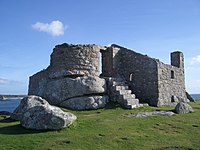
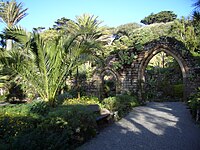
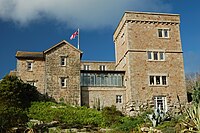
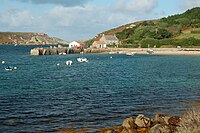
- English Civil War:
- King Charles's Castle dates from 1550–54, and was occupied by the Royalists during the English Civil War. It was later partially demolished to provide the building materials for Cromwell's Castle.
- A coastal tower known as Cromwell's Castle, was built 1651-52 with gun platform added ca. 1740 by Abraham Tovey, Master Gunner.
- The Old Blockhouse gun tower protecting Old Grimsby harbour, vigorously defended during the Civil War. It was probably built between 1548 and 1552.
- Oliver's Battery, in the south of the island, by the Carn Near quay, erected shortly after the capture of Tresco by Parliamentary forces in the English Civil War. It was built by Admiral Robert Blake.
- Other sights:
- Monument to Augustus Smith above Appletree Bay on the south west of the island.
- Arch from the wall of the mediæval monastery in Tresco Abbey Gardens.
Transport
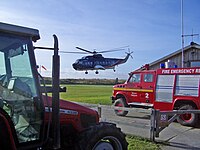
Tresco is a car-free island. Farm tractors with passenger trailers are used to transport overnight visitors to and from Tresco Heliport and from the various quays, and a few golf carts are available for disabled visitors.
British International Helicopters operate from Tresco Heliport, providing a year-round helicopter service to Penzance Heliport.
Bryher Boats run passenger boat services to and from the other inhabited islands, as well as occasional circular sightseeing tours.
Wildlife
Among the many vagrant birds which have been found here are the following, which was a first for Britain, a Western Sandpiper (Calidris mauri) Originally identified as a Semipalmated Sandpiper, 1969
Cultural references
Tresco in books
Because of its geography and history, Tresco has often featured in fiction. Most notably in the books of author Sam Llewellyn, a direct descendant of Augustus Smith who, after his appointment as Lord Proprietor of the Scillies in 1834 and living on the island, began to create the Abbey Gardens on land which surrounded the old Priory.
- Flora Castledine, lead character of the Georgie Gale novel Tread Softly, was born and brought up on the Isles of Scilly. Tresco is mentioned several times.
- Why the Whales Came by Michael Morpurgo is set in the Isles of Scilly and features Tresco several times.
- Hell Bay, by Sam Llewellyn, is set on Tresco and fictionalises the events leading up to Augustus Smith's taking ownership of the island.
- The Sea Garden, also by Sam Llewellyn, is set on a fictional island based heavily on Tresco. It features a stunning Sea Garden much like the Tresco Abbey Gardens and the history of the fictional island draws heavily from the real history of the island.
- Storm Islands, by Ann Quinton, is a mystery novel set on Tresco and in the Isles of Scilly.
Tresco on film
- The Voyage of the Dawn Treader (BBC television adaptation, the scenes on the Lone Islands were filmed on Tresco, and the on-ship scenes being filmed on a ship on the surrounding sea.
- Archipelago (2010) has Tesco as its setting
Outside links
| ("Wikimedia Commons" has material about Tresco) |
- Isles of Scilly Wildlife Trust
- 'The Last Piece of England' - An illustrated history of Tresco from the Bronze Age to the present
References
- ↑ Tresco.co.uk
- ↑ Deformation tills are sediments which have been disaggregated and (usually) homogenised by shearing in the sub-glacial deformed layer.
- ↑ Van der Meer, J., et al. (2003) "Subglacial Till: the deforming glacier bed", in: Quaternary Science Reviews; Vol. 22, pp. 1659–85
- ↑ Cornish Church Guide; p. 194
- ↑ Alford, Rev. D. P. (1891). The Abbots of Tavistock with Views Beyond. Plymouth: W. Brendon & Son. p. 123. http://www.archive.org/details/abbotsoftavistoc00alfo.
- ↑ 'The Scilly Islands', Magna Britannia: volume 3: Cornwall. 1814. pp. 330–337. http://www.british-history.ac.uk/report.aspx?compid=50654.
- ↑ The Duchy of Cornwall, by Crispin Gill and Martin Argles. David & Charles, 1987. ISBN 0715388916
- ↑ Tresco Marathon
- ↑ Squadron histories: R.F.C., R.N.A.S. and R.A.F., since 1912 by Peter Lewis. 1968. Page 82
| Isles of Scilly |
|---|
|
St Mary's •
St Agnes •
Tresco •
Bryher •
St Martin's •
Gugh
|
